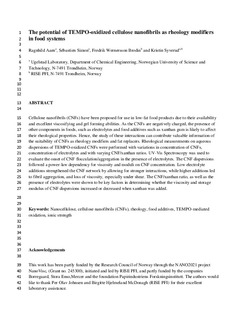| dc.contributor.author | Aaen, Ragnhild | |
| dc.contributor.author | Simon, Sebastien Charles | |
| dc.contributor.author | Brodin, Fredrik Wernersson | |
| dc.contributor.author | Syverud, Kristin | |
| dc.date.accessioned | 2019-05-24T06:55:02Z | |
| dc.date.available | 2019-05-24T06:55:02Z | |
| dc.date.created | 2019-05-22T08:15:13Z | |
| dc.date.issued | 2019 | |
| dc.identifier.citation | Cellulose. 2019 | nb_NO |
| dc.identifier.issn | 0969-0239 | |
| dc.identifier.uri | http://hdl.handle.net/11250/2598625 | |
| dc.description.abstract | Cellulose nanofibrils (CNFs) have been proposed for use in low-fat food products due to their availability and excellent viscosifying and gel forming abilities. As the CNFs are negatively charged, the presence of other components in foods, such as electrolytes and food additives such as xanthan gum is likely to affect their rheological properties. Hence, the study of these interactions can contribute valuable information of the suitability of CNFs as rheology modifiers and fat replacers. Rheological measurements on aqueous dispersions of TEMPO-oxidized CNFs were performed with variations in concentration of CNFs, concentration of electrolytes and with varying CNF/xanthan ratios. UV–Vis Spectroscopy was used to evaluate the onset of CNF flocculation/aggregation in the presence of electrolytes. The CNF dispersions followed a power-law dependency for viscosity and moduli on CNF concentration. Low electrolyte additions strengthened the CNF network by allowing for stronger interactions, while higher additions led to fibril aggregation, and loss of viscosity, especially under shear. The CNF/xanthan ratio, as well as the presence of electrolytes were shown to be key factors in determining whether the viscosity and storage modulus of CNF dispersions increased or decreased when xanthan was added. | nb_NO |
| dc.description.abstract | The potential of TEMPO-oxidized cellulose nanofibrils as rheology modifiers in food systems | nb_NO |
| dc.language.iso | eng | nb_NO |
| dc.publisher | Springer Nature | nb_NO |
| dc.relation.uri | https://link.springer.com/article/10.1007%2Fs10570-019-02448-3 | |
| dc.title | The potential of TEMPO-oxidized cellulose nanofibrils as rheology modifiers in food systems | nb_NO |
| dc.type | Journal article | nb_NO |
| dc.type | Peer reviewed | nb_NO |
| dc.description.version | acceptedVersion | nb_NO |
| dc.source.journal | Cellulose | nb_NO |
| dc.identifier.doi | https://doi.org/10.1007/s10570-019-02448-3 | |
| dc.identifier.cristin | 1699356 | |
| dc.relation.project | Norges forskningsråd: 245300 | nb_NO |
| dc.description.localcode | This is a post-peer-review, pre-copyedit version of an article published in Cellulose. Locked until 2 May 2020 due to copyright restrictions. The final authenticated version is available online at: https://doi.org/10.1007/s10570-019-02448-3. | nb_NO |
| cristin.unitcode | 194,66,30,0 | |
| cristin.unitname | Institutt for kjemisk prosessteknologi | |
| cristin.ispublished | true | |
| cristin.fulltext | original | |
| cristin.fulltext | postprint | |
| cristin.fulltext | preprint | |
| cristin.qualitycode | 1 | |
